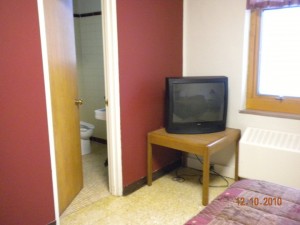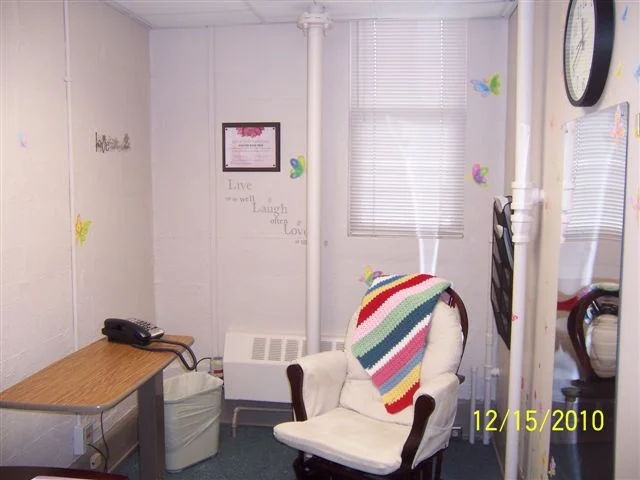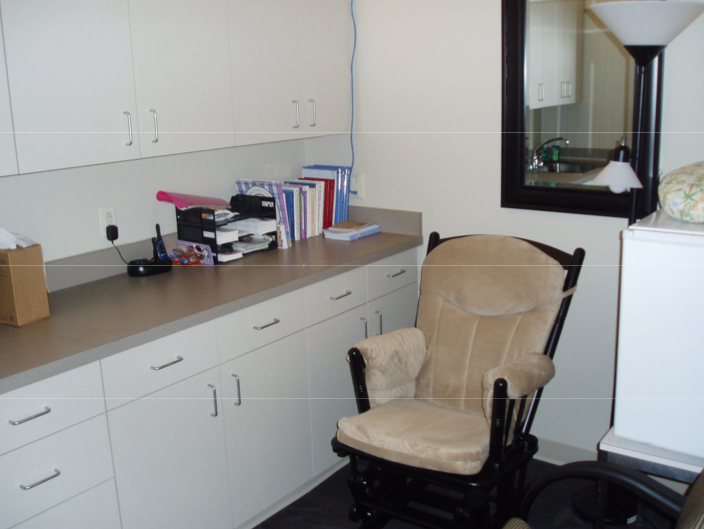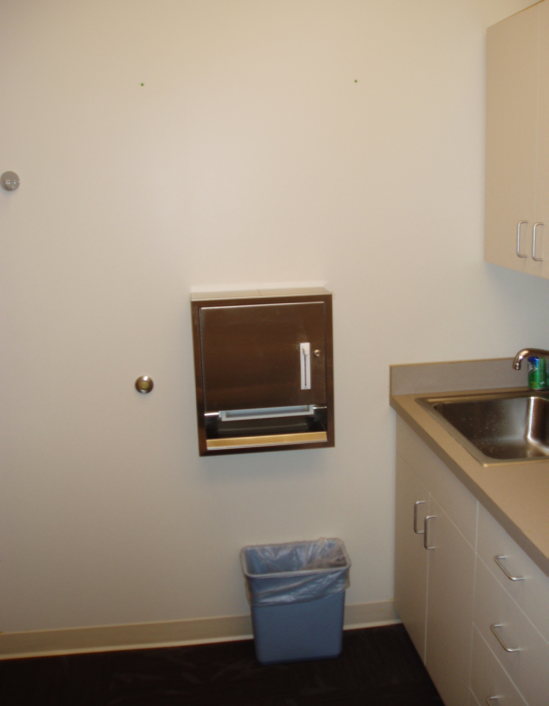The Business Case for Breastfeeding is part of a nationwide emphasis of the U.S. Department of Health and Human Services (HHS), Health Resources and Services Administration’s Maternal and Child Health Bureau aimed at encouraging women to breastfeed their infants for a longer duration after they return to work. The State of Iowa was one of 10 states selected by HHS in 2009 to receive funding to promote breastfeeding in the workplace. The Iowa Breastfeeding Coalition used part of that funding to provide 9 businesses throughout the state $500 grants to create or improve lactation rooms at their workplace. Each of these businesses desired to provide lactation support to breastfeeding employees. Congratulations to the businesses who received funding:
Siouxland District Health Department - Sioux City, Iowa
Johnson County Public Health - Iowa City, Iowa
Kimberly Center - Davenport, Iowa
Dallas County Public Health - Adel, Iowa
Sioux Center Community Hospital & Health Center - Sioux Center, Iowa
West Central Community Action - Harlan, Iowa
Manning Regional Healthcare Center - Manning, Iowa
Siouxland Community Health Center - Sioux City, Iowa
Broadlawns Medical Center - Des Moines, Iowa
Impact of the Grant Six months to one year after receiving the grant money to start or upgrade their lactation rooms, the IBC asked recipients what kind of impact their rooms had on their breastfeeding promotion. Here is a sampling of the responses.
Manning Regional Healthcare Center: “There have been several employees that have chosen to breastfeed their babies once they have returned to work. The lactation room is solely used by our breastfeeding employees and they have commented that is feels very comfortable. To help with questions or concerns from our breastfeeding employees, we have provided educational information and books along with contact information of an International Board Certified Lactation Consultant. I’m not sure if this room has changed the amount of time the employee has chosen to breastfeed, but I know that it has made it easier for them to do so.”
Broadlawns Medical Center: “The lactation room has been a wonderful addition to our hospital. Initially finding an adequate space centrally located was our biggest obstacle. With the use of the grant we turned a small file room into a basic lactation room. It was amazing that with new paint, pictures, nursery stickers and furniture how homey this room evolved for our breast pumping staff. A key is offered to each mother who would like to use it on a daily basis or for continued use. Usage varies from returning new mothers to mothers with babies over 1 year. The lactation room has made it possible for staff to continue to maintain their breastmilk supply for as long as they desire. Our breast pumping users have described the room as ‘fabulous and thrilled to have a room that may be used without interruptions.’”
Siouxland District Health Department: “Having the designated Lactation Room, along with the federal legislation regarding pumping in the workplace and our WIC Peer Breastfeeding Counseling Program has greatly increased the opportunity to discuss the benefits and availability for staff to use this feeding method. The presence of the Lactation Room within Siouxland District Health Department has placed breastfeeding as a visible employer support for the breastfeeding women within our workplace.”
Sioux Center Community Hospital: “We continue to see that the rooms are used by staff as well as visitors. Staff uses the rooms for break time breast pumping and visitors use the rooms for breastfeeding a child or rocking, changing diapers, etc. The focus towards quiet and privacy away from more public and patient care areas facilitates breastfeeding and meeting other care needs for infants and toddlers. We feel the addition of these rooms in our facilities has been successful and supportive of our efforts to encourage breastfeeding. Some lessons learned include 1) having a designated space for our staff that is private, close to work and they can leave their equipment, bags, etc. has been popular and has facilitated room use. 2) It is difficult to keep tally sheets. This isn’t as important to those using the room as it is to those of us wanting to measure utilization.”
West Central Community Action: “Prior to the grant WCCA just used offices or any spot that was available. Since the grant we have identified rooms in all our facilities that are adequate for breastfeeding. The supplies we have been able to provide have made it handy for staff to use the rooms and not feel like they are messing up someone’s office or interfering with other business processes. I believe the staff are glad to have an assigned area that provides quiet, comfort and supplies. They don’t have to worry anymore about being walked in on and they don’t have to ‘find’ a spot to breastfeed. When clients see staff breastfeeding they have a common link to issues and concerns and do more than promote breastfeeding…they are promoting trust and confidence for the clients.”
Johnson County Public Health: “Our lactation room is used by both employees and WIC participants who are nursing. An added benefit is that we have a private place to observe and instruct when WIC clients report problems breastfeeding. The items purchased with the grant funds have greatly increased the attractiveness and comfort of the room. We believe this has led to employees seeking out the room and continuing to use it because of their positive experiences. We believe the lactation room has sustained breastfeeding for employees. Knowing that there is a place to comfortably breastfeed is just one more way to make it easier for employees to plan on breastfeeding upon returning to the workplace.”
Kimberly Center: “We have had an increase in the number of students who breastfeed. Since the beginning of the school year, we have had 4 students and one teacher who breastfed. We use our room to do some instruction prior to delivery. One thing to change is to start teaching earlier, repeat the teaching, review issues that can occur after they leave the hospital and be sure they know they can call the hospital for assistance. It has definitely encouraged our students. Our most successful moms have stopped breastfeeding after a few months, but we are excited with the increased interest in breastfeeding over the past couple of years. Our room is a comfortable, private place where our moms can relax and pump or feed their babies. The nutritional value is so important but in addition, breastfeeding gives our girls ‘permission’ to sit with their infant, relax, nurture, and enjoy being a mother!”
Siouxland Community Health Center: “One key lesson learned is to increase awareness about the lactation room, its availability, and enhance promotion of its use to employees who are nursing mothers. The room has encouraged workplace lactation. Educational materials from the Iowa Department of Public Health supplement the program and also encourage breastfeeding among female employees with infant children. While it is not known if nursing mothers will breastfeed longer as a direct result of the program, having the lactation room available in the workplace is expected to support a longer duration of breastfeeding with increased convenience and accessibility to an environment that encourages workplace lactation. The room has provided an added benefit to employees who are nursing mothers with dedicated space for workplace lactation. This designated space, while providing comfort and privacy, minimizes interruption to daily work and allows convenience for breast milk expression during working hours.”
Additional information Below are additional comments and photos from some of the grant recipients:
Sioux Center Community Hospital & Health Center
"Our initial goal was to create one room, but we decided to expand the project to better serve our employees by creating 3 "Mother's Rooms." All three are convenient, safe, private, and comfortable rooms. We are hopeful these rooms would also be used by other breastfeeding mothers visiting our facilities. A fourth room will be completed in the near future. In addition to the rooms, we established a lactation support policy and developed an information card to be distributed by our OB staff to new mothers during hospitalization or by supervisors at the time a maternity leave is requested. To evaluate the project we are using a talley sheet to show overall utilization of the rooms on a monthly basis."
Siouxland District Health Department
This group set up a State of the Art Model lactation room by converting over a clinic exam room. It had a locking door and emergency assistance if needed as well as a sink with hot and cold running water and lockable cabinets for supply storage. The grant money was used to purchase a glider rocker and small table. They announced that the room was available at the agency managers meeting and all-agency staff meeting.
West Central Community Action
"WCCA identified 30 rooms to be used for breastfeeding. Locks were purchased and installed, large tubes of disinfectant wipes were purchased as well as room signs for all 30 rooms. Foot stools have been ordered."
Broadlawns Medical Center
"We were excited when Iowa was selected to participate in this program by the HSS," stated Susan Kirstein, MSN, chief nursing officer at Broadlawns medical Center. "It's gratifying to receive the grant. We needed a lactation support program at Broadlawns to allow us to lead by example in eliminating barriers for employees. We encourage and support our patients and community members in breastfeeding their babies, yet we had barriers for our own employees who wanted to continue breastfeeding after returning to work."
The grant is being used to provide room signage and a safety lock for privacy of the users, as well as sanitation supplies for the room. Broadlawns has supplied space with a reclining chair, educational materials and staff support to satisfy the required in-kind matching support for the project.
Johnson County Public Health
"Though a previous lactation room was built to meet many of the Basic Model Lactation Area standards, adding and changing just a few items moved the room to the Even Better Model for a Workplace Lactation Area. These changes included a comfortable chair and footstool, disinfectant wipes and dish soap, a wall clock, a floor lamp and a mirror. To increase awareness and use of the room by employees, educational materials were developed and distributed to all employees in the bi-monthly newsletter. Room use was tracked before and after the educational campaign and placement of the new amenities. From mid-July to mid-August, room use increased over 15%. One woman commented that the availability of the room influenced her decision to breastfeed."
Kimberly Center
"We recently met with the peer counselors and all agree that it would be helpful to the students if we make referrals to them earlier so they can establish a relationship prior to the student's delivery. We have started meeting with the pregnant and parenting students in a group setting and continue to meet with them individually."
This group plans to determine the success of their lactation room by tracking the number of pregnant students who express an interest in breastfeeding and those who do breastfeed. They will interview those students who stop breastfeeding to identify problems/difficulties they encountered and those students who continue breastfeeding every 2-3 months to see how it is going for them.
Siouxland Community Health Center
"The primary goal of the workplace lactation support program is to create a workplace environment that is safe, nurturing, and responsive to employee needs. Specifically the program is designed to:
Provide a safe and private area to support milk expression and flexible work options for breastfeeding mothers.
Promote the health benefits of breastfeeding for mother and infant.
Improve productivity and retention for breastfeeding mothers including lower absenteeism and turnover.
With the guidance of the Human Resources Department, we are writing a lactation support policy. Our grant money will pay for storage lockers and a gliding chair."
Dallas County Public Health
"Therefore let it be resolved that the Dallas County Board of Supervisors will provide a supportive environment for lactating employees including reasonable breaks and an appropriate location." This was the first step in our efforts to offer a specific lactation room to all county employees located within the department of Public Health. This location allows nursing mothers access to the public health nurse that is a Certified Lactation Consultant in case they have questions about breastfeeding or operating the pump.
In addition to purchasing a Medela Lactina Select Multi-User Double Breast Pump with the grant, Dallas County provided many things for their lactation room: The lock on door, curtains, lactation sign, bulletin board, books/literature, rocking chair, music/CD player, wall clock and decor, telephone, antiseptic wipes, sink in room next door. The bulletin board shows pictures of babies who's moms are currently using the room under the "breastfeeding boot camp" side and photos of the "graduates" who's mothers have used the room in the past but are no longer breastfeeding.
Manning Regional Healthcare Center
"Manning Regional Healthcare Center can now provide a clean, comfortable and private space where nursing mothers will have a way to pump after returning to work. Originally we wanted to provide a sink outside the room and MRHC would purchase a compact refrigerator. The space we found for the lactation room was large enough to put a sink inside the room. After discussion with the current and soon-to-be-breastfeeding mothers, it was decided to not purchase a refrigerator as the mothers said they would be utilizing the refrigerators in or very near their departments rather than one in the lactation room. Funds from IBC were used to purchase a TV, trash can, paper towel and soap dispensers, and an Occupied sign. MRHC provided room renovations, a rocker, a Medela Symphony Breast Pump, an end table, oscillating fan and a hook for the Occupied sign."














